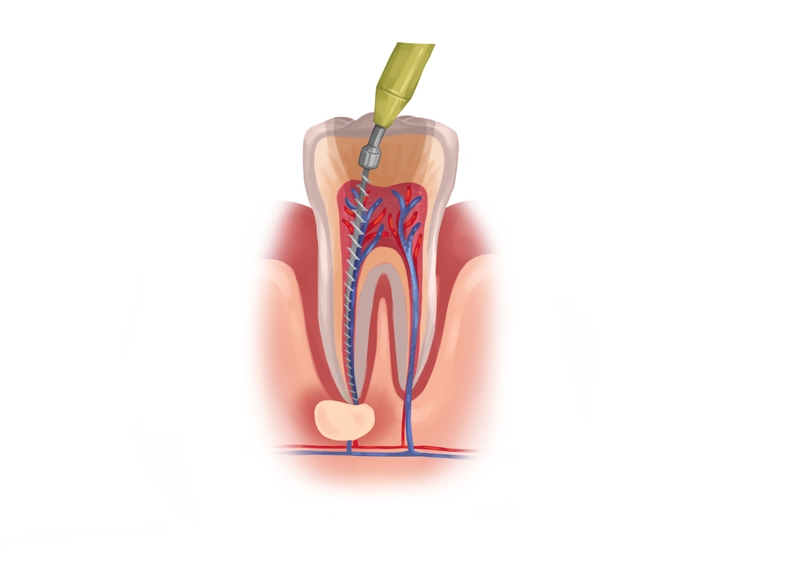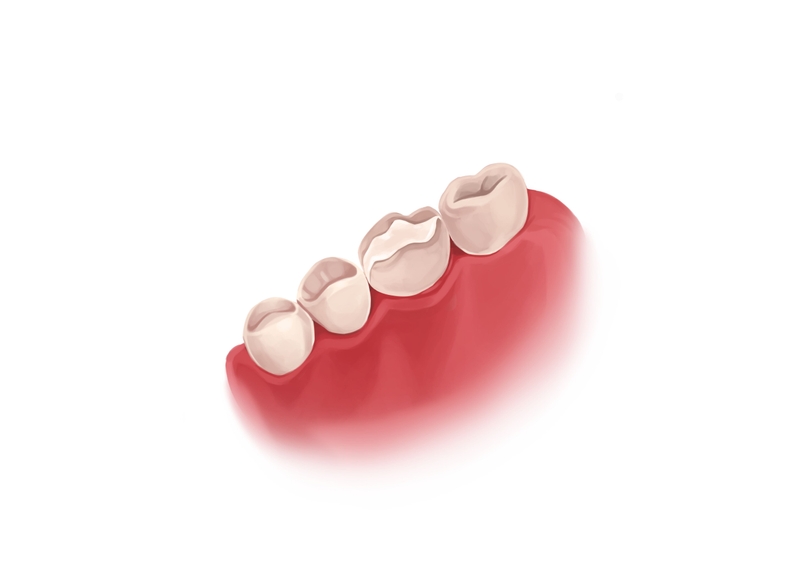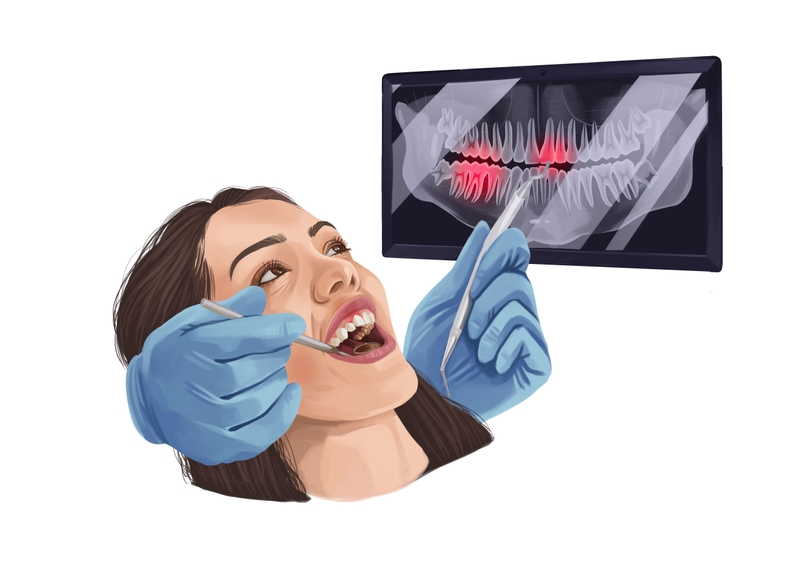- The cost of a root canal treatment can be as high as $2,100. This price does not include additional procedures that may be required.
- The location and complexity of the tooth, as well as the number of canals, may affect the cost of the procedure.
- Your dental plan may cover some of the costs but these procedures can quickly deplete your insurance credit.
Need a low-cost root canal? Use Authority Dental to find affordable dental services near you. Need a same-day treatment? Book emergency dental care services.
Are you wondering what are the costs of root canal treatment? Here's everything you need to know.
Average cost of root canal

Picture by Authority Dental under CC 2.0 license
The biggest factor that regulates the price for a root canal treatment is the category (or the location) of the tooth involved. This could be a front one, a bicuspid, or a molar. The further back the tooth the more complicated the procedure.
The number of canals is also important. If there are more canals to treat the cost will be higher too.
Other factors that might influence the cost of root canal therapy include having an infected tooth, which can certainly affect the restoration procedure.
| FIRST ROOT CANAL TREATMENT | AVERAGE COST | COST RANGE |
|---|---|---|
| Anterior tooth | $1,000 | $700-$1,700 |
| Bicuspid tooth | $1,100 | $800-$1,800 |
| Molar tooth | $1,300 | $850-$2,100 |
What’s more, it may happen that the initial treatment fails. If this does happen, you will be looking at additional, higher costs that your dental insurance may cover or not.
| ROOT CANAL RETREATMENT | AVERAGE COST | COST RANGE |
|---|---|---|
| Anterior tooth | $1,200 | $750-$1,900 |
| Bicuspid tooth | $1,350 | $850-$2,100 |
| Molar tooth | $1,550 | $950-$2,400 |
Some treatments are unsuccessful. If the pain is not decreasing the dentist might suspect a vertical fracture or calcification of the canal. In such an event the treatment cannot be completed and you will be charged for the time spent by the dental professional only.
Incomplete root canal therapy costs $500 on average. The prices range from $250 up to $850.
This visit would typically end with a temporary filling. Many offices don’t bill separately for this, but it is a possibility. Moreover, you can expect a fee for extraction of the tooth or a referral to an endodontist if the RCT were to fail.
Associated costs

Picture by Authority Dental under CC 2.0 license
There are many procedures related to root canal treatment.
| PROCEDURE | AVERAGE COST | COST RANGE |
|---|---|---|
| Dental exam | $100 | $50-$200 |
| Periapical X-ray | $35 | $25-$50 |
| Panoramic X-ray | $130 | $100-$250 |
| Cone beam CT | $350 | $150-$750 |
| Apicoectomy | $1,150 | $600-$2,100 |
| Root canal obstruction treatment | $350 | $150-$900 |
| Internal root repair | $300 | $200-$850 |
| Laughing gas | $90 | $40-$150 |
| Non-intravenous conscious sedation | $250 | $75-$500 |
| Protective restoration | $150 | $90-$250 |
| Dental crown | $1,250 | $200-$2,500 |
Your dentist will decide which are needed in your case.
Dental exam
You are likely to pay for an oral evaluation before your root canal visit. The dentist will assess whether you need a root canal treatment and whether you are a good candidate. He or she may perform cold testing, hot testing and electric pulp testing of the teeth, which could be an additional cost, too. This will determine whether the tooth is living or dead.
If the canal is obliterated (calcified) or very curved you might need to have an RCT under a microscope. This is almost always done by an endodontist, which drives up the cost.
During dental exams, you should report any symptoms you are experiencing, as this will help diagnose the problem. The steps involved in the root canal procedure will also be explained to you.
Dental X-rays
As mentioned above, a dental X-ray is a cost you often have to take into account before (and sometimes after) a root canal treatment. They help perform the procedure safely by showing the dental professional the extent of the infection as well as inner structures of the tooth, such as canal length.
The types of dental X-rays you can expect are:
a periapical x-ray,
a panoramic x-ray, and
a cone-beam CT.
Apicoectomy
This is a minor surgical procedure during which the tip of the tooth’s root is removed. This is done only if an infection leading to an abscess develops in this area. It is performed as a last resort.
It should be done as soon as possible, so you might have it the same day as your RCT. Once you have an apicoectomy you cannot have root canal retreatment on this tooth again. An RCT always takes place prior to an apicoectomy, though.
The only alternative is extraction. By removing the tip, however, the natural tooth can be saved. This procedure is usually carried out by an endodontist.
Similarly to RCT, the cost is related to the position of the tooth. A molar will be the most expensive.
Root canal obstruction treatment
Sometimes access to the root is difficult. This could be due to pulpal stones (calcification inside the pulp chamber) or canal strictures (the shape of the canal does not permit access). This would be the basis for a referral to an endodontist.
In order to reach the problem area, a pathway has to be formed. The endodontist will use a special drill and a microscope.
This procedure usually takes a long time; an additional fee might be charged accordingly. Nonetheless, this situation is rare.
Internal root repair
If the integrity of the tooth was broken in an unnatural way (i.e. perforation defect) internal root repair might be needed. The endodontist will need to reach the problem area and disinfect it.
A very expensive paste containing calcium hydroxide will be placed on the perforation site. This area often bleeds heavily, and this will have to be contained as well.
This procedure, including the healing period, is very time-consuming. X-rays will have to be performed to confirm that you are recovering properly. You will have to return once more for root canal retreatment.
Anesthesia
Local anesthesia is most commonly used for RCT to avoid pain. This may be a simple injection included in the price of the treatment. If the patient is very anxious nitrous oxide (a laughing gas) might be used.
As regards the laughing gas it will usually cost just under $100. It is cheaper than non-intravenous conscious sedation, which might come out to about $250.
Conscious sedation means that you will be able to follow instructions, but most likely will not remember the procedure. IV sedation might be offered for extreme cases.
Protective restoration
The tooth needs to be secured after the treatment to prevent damage. Most often a temporary filling is inserted until a permanent crown is fitted. Sometimes a post is placed and the core is built up before a crown can be fashioned. Those will be charged separately.
You might be charged for the filling independently as well. A full crown will be more expensive and the final decision whether to fit one will be made by the dentist. Sometimes a crown is the only possibility, especially with molar teeth.
Dental crown
You will probably be fitted with a temporary crown while the permanent one is being made.
Those can be divided into relatively cheap and staggeringly expensive options. Some choose to have a filling permanently, as it is a lot cheaper. This is not always possible, for example in the case of molars.
The material and expertise of the dentist are the most important in determining the cost of the crown. By following this link you can find a separate calculator, similar to the one above, that is dedicated to estimating crown prices.
Does insurance cover root canal treatment?

Picture by Authority Dental under CC 2.0 license
Depending on your dental plan, some of the costs related to root canal treatment may be covered. You might be reimbursed for a portion of the price for the dental visit (20%-80%). Since those procedures are expensive, however, they can take up a lot of your insurance credit.
This means that the yearly cap (usually around $1,000) can be reached quite quickly meaning that pocket costs could rise even more.In the event that this happens early on in the year, your provider won’t cover any other procedures.
The solution is to sign up for a dental discount plan and check at the dental office if you can get a payment plan. Those can be used independently of insurance but also after the annual limit is reached. They allow you to save up to 60% on all dental procedures. You pay a monthly or yearly fee and have to visit in-network dentists.
There are no yearly caps or paperwork. You don’t have to collect evidence that treatment was medically necessary. You can even use them on cosmetic procedures. A lack of waiting periods means saving up from the day you sign up.
FAQ
Why is a root canal so expensive?
Root canal treatment is a complicated and delicate procedure. It is often the last resort to save a tooth that would otherwise need to be extracted. The procedure also comes with a degree of risk, as it sometimes fails.
The biggest determinants of the price are the number of canals, which can be different for each patient, and which tooth is being treated. The further back your tooth is, the more expensive the procedure may be.
Is root canal cheaper than tooth extraction?
In most cases, no. However, when a tooth is extracted it should be replaced with an artificial one. Bearing in mind the costs of such a solution, saving the natural tooth might be more affordable in the long term.
Dentists almost always advise that the best solution is to do whatever you can to save a tooth rather than remove it.
What happens if you can't afford a root canal?